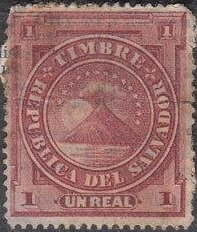Stamp: Coat of arms within circle (El Salvador 1885)
Coat of arms within circle (El Salvador 1885)
01 January (El Salvador ) within release Coat of arms within circle goes into circulation Stamp Coat of arms within circle face value 1 Salvadoran real
| Stamp Coat of arms within circle in catalogues | |
|---|---|
| Forbin: | For: SV D9 |
Stamp is square format.
|
Data entry completed
50%
|
|
|---|---|
| Stamp Coat of arms within circle in digits | |
| Country: | El Salvador |
| Date: | 1885-01-01 |
| Perforation: | 14½ |
| Emission: | Revenue |
| Format: | Stamp |
| Face Value: | 1 Salvadoran real |
Stamp Coat of arms within circle it reflects the thematic directions:
A coat of arms is an heraldic visual design on an escutcheon (i.e. shield), surcoat, or tabard. The coat of arms on an escutcheon forms the central element of the full heraldic achievement which in its whole consists of shield, supporters, crest, and motto. A coat of arms is traditionally unique to an individual person, family (except in the United Kingdom), state, organisation or corporation.
A star is a luminous spheroid of plasma held together by self-gravity. The nearest star to Earth is the Sun. Many other stars are visible to the naked eye at night; their immense distances from Earth make them appear as fixed points of light. The most prominent stars have been categorised into constellations and asterisms, and many of the brightest stars have proper names. Astronomers have assembled star catalogues that identify the known stars and provide standardized stellar designations. The observable universe contains an estimated 1022 to 1024 stars. Only about 4,000 of these stars are visible to the naked eye—all within the Milky Way galaxy.
A volcano is a rupture in the crust of a planetary-mass object, such as Earth, that allows hot lava, volcanic ash, and gases to escape from a magma chamber below the surface. The process that forms volcanoes is called volcanism.



